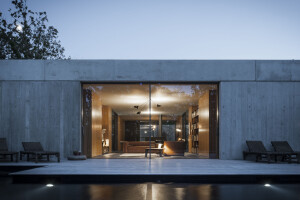刘家小院
桃舍 PEACH HOUSE, Beijing– Rural housing construction owes little to the State and household savings even enable to build private ownership. By allowing the purchase of materials from local manufacturers and artisans, self-built housing construction is prevalent in rural areas. Private property goes back to the agricultural reform of the 1950s, which did not succeed in establishing collective habitations, but reaffirmed the notion of private property as the expression of the work of the family. They are the homes of peasants – inherited or built with domestic savings. The courtyard house in North China constitutes a form of housing which is the result of a long process of interaction between the built form and social, economic, and cultural needs and habits.
The task of building a new courtyard house required to examine and engage with modes of life in rural areas of Beijing. An extended analysis of the specific building type, the built environment, the social and historical context and finally the requirements for the new use were absolutely essential prior to the design process. In a preliminary study, the site and its previous buildings were retraced and documented through a graphic reconstruction to understand its layout and function. A timeline starting from the 1950s reveals the different states and transformations the site and buildings underwent. One of the most important characteristics of the courtyard house is its flexibility in accommodating growth and change.
The objective was to build a new courtyard house, by lifting the courtyard and creating a space for a convenience store on the ground floor. The ground floor level was lowered and a new concrete slab poured inside the existing building for the upper floor. To follow traditional room layouts and build according to the principles of Feng Shui, the new floor plan was modeled on the typical courtyard house in North China. Special attention had to be paid to the angle and grid of the layout, the positioning of columns and openings to meet all requirements. The building is arranged on a North-South oriented lot, with the main pavilion facing South. The access gate is situated in the South-East corner according to traditional layouts. Ceiling heights and spacing had to follow a specific hierarchy. The layout of the elevated courtyard is introverted to ensure privacy in the courtyard and that of adjacent houses.
The blue or grey brick is historically prevalent in Beijing and the northeastern region of China, but is less and less used for various reasons nowadays. Cheaper red bricks are mostly used in self-built housing today. The facade design with two different brick colors dissipates the contrast and creates a balance. Moreover, visible scorch marks on red bricks merge the two tones.
桃舍, 北京
农村住房建设对国家而言几乎没有任何影响,家庭储蓄甚至可以建立私人所有权。通过允许从当地制造商和工匠购买建筑材料,自建房屋建设在农村普遍存在。私有财产可以追溯到20世纪50年代的农业改革,没有成功地建立集体居住区,但重申了私人财产是家庭工作表达的概念。他们是农民的家园 - 由国内储蓄继承或建造。华北四合院是一种住房形式,是建筑形式与社会,经济,文化需求和习惯长期相互作用的结果。
建造一个新的四合院的任务需要了解和参与北京农村的生活方式。在设计过程之前,对具体建筑类型,建筑环境,社会和历史背景以及最终新用途的要求进行扩展分析是绝对必要的。在初步研究中,该房旧址及其以前的建筑物通过图形重建进行回溯和记录以了解其布局和功能。从20世纪50年代开始的时间表揭示了老房旧址和建筑物的不同状态和变化。四合院最重要的特征之一是其适应增长和变化的灵活性。
此项目是建造一座新的四合院,方法是提起庭院并在底楼的便利店创造一个空间。地面层被降低了,并且一个新的混凝土楼板放置在现有房屋的楼上。按照传统的房间布局,按照风水的原则建造,新的平面图仿照华北典型的四合院。必须特别注意布局的角度和框架,柱子和门窗的位置以满足所有要求。该建筑物位于南北向的地块上,正房朝南。大门根据传统布局位于东南角。天花板的高度和间距必须遵循特定的等级。高架庭院的布局是内向的,以确保庭院和相邻房屋的隐私。
蓝色或灰色砖在北京和中国东北地区历史上盛行,但由于种种原因越来越少使用了。今天,廉价红砖主要用于自建房屋。两种不同砖色的立面设计消除了对比并创造了平衡。此外,红砖上可见的焦痕会合并两种色调。






































